There are few things to which we pay as much attention as the passage of time. We don’t want to be late for work, or a date. Even more importantly, we don’t want to age and die. Good time keeping is an all important human activity, and we started to worry about it as soon as we abandoned our hunter-gatherer lifestyle and agriculture and commerce emerged.
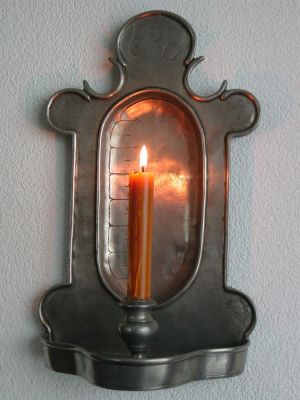
Measuring time needs two things: a repetitive process to mark equal increments of time, and a way of tracking and displaying the result. The first timekeeping devices relied of course on the movement of the sun. Ancient Egyptians, around 3500 BC, built obelisks that, by casting a shadow on the ground at different positions, gave an approximate idea of the time. Next came the use of some medium that was consumed at a regular pace: candle, incense, water and sand clocks are examples. A great advancement came with the advent of the mechanical clock, and here is where the escapement mechanism appears.

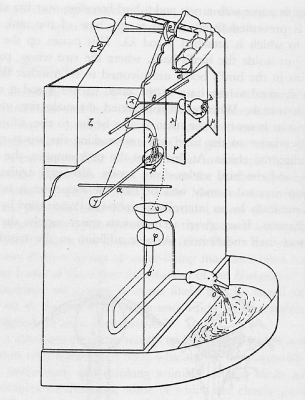
A clock needs energy to work. Think of the escapement as a way to release that energy in small quantities at constant intervals. In the animation at the right, the wheel is connected to the source of energy: a spring or weight. By itself, the wheel will rotate continuously as fast as it can until the energy stored in the spring is exhausted. But if we add the anchor shaped piece, the wheel rotates a few degrees at a time, in constant time intervals, just what we need for time measurement.
The earliest known escapement was described by the Greek engineer Philo of Byzantium in the 3rd century BC. From the Wikipedia entry: A counter weighted spoon, supplied by a water tank, tips over in a basin when full, releasing a spherical piece of pumice in the process. Once the spoon has emptied, it is pulled up again by the counterweight, closing the door on the pumice by the tightening string.
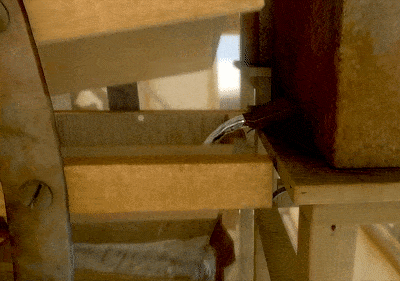
Another early escapement was built by famous Chinese inventor Su Song in 1094. It used a large water wheel to keep time. The wheel is stopped by a mechanism that will only release once the weight in the currently filling bucket reaches a certain level. As long as the water flows at a constant rate, the wheel rotates at constant time intervals too. It is known as an Astronomical Clock Tower and was very large. Although lost to antiquity, this animated rendering of the structure, originally shown on the History Channel’s Ancient Discoveries, gives a good feel for what the structure was like and how it worked.
The first all-mechanical clocks were made possible thanks to the Verge escapement. It appeared in 14th century mechanical clocks found in large towers along Europe, and its origin is unknown. Perhaps the accuracy was not much better than that of the water clocks, but at least they did not freeze in winter. The verge escapement remained the king of time-keeping for four centuries, until the invention of the pendulum and balance spring in 1657, which increased the accuracy from hours a day, to minutes a day.
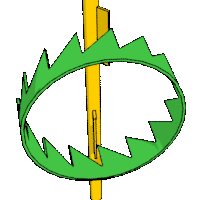
After pendulum clocks were invented, a large number (more than 300!) of escapement designs were developed. Of course only a few of them remained in use. Some of the most important types are:
- Cylinder Escapement, by Thomas Tompion And George Graham, 1695-1726.
- Duplex Escapement, by Robert Hooke, 1700.
- Lever Escapement, Thomas Mudge, 1750.
- Chronometer/Detent Escapement, John Arnold, 1775.
An extremely interesting design is the grasshooper escapement, developed in 1722 by John Harrison. It has a very unusual, almost hypnotic movement. Its main advantage is that it is a mechanism of very low friction.
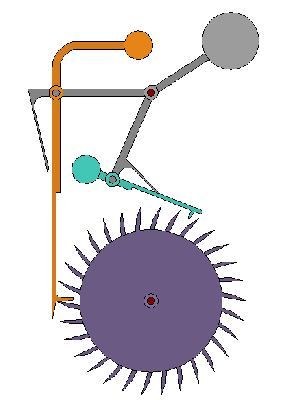
Mechanical clock development continued, with great advances in both accuracy and miniaturization, and the escapement was a central part of every clock. But the advent of the electric clock replaced the escapement mechanism with electric means of producing the regular pulses needed in a clock: solenoids, synchronous motors and tuning fork oscillations. Eventually, we ended up with clocks with no clockwork parts at all.
In 1927, the first quartz clock was built in Bell Telephone Laboratories. These clocks use the regular oscillations of the quartz crystal to measure the time intervals. Seiko introduced the first quartz clock, the Astron, in 1969. A decade later, the market was dominated by quartz. The combination of low cost and accuracy of the quartz clock led the “quartz crisis“, where mechanical watches almost disappeared from the market.
The final refinement came with atomic clocks, which use the electronic transition frequency of atoms to measure time. This has resulted in unparalleled timekeeping accuracy. They are found in satellites used in the GPS network and any device that syncs with them will benefit from this high-precision timekeeping. In the near future, you will probably have one in your wristwatch, as they have been miniaturized to chip scale.

Today, mechanical watches that use an escapement mechanism are still manufactured. Of course, we don’t need them. After all, now that we all have cell phones, even the quartz wristwatch becomes redundant. However, there is an inherent beauty in that miniature mechanism. They represent the triumph of craftsmanship over precision.
Mechanical watches are so brilliantly unnecessary. Each one is a miniature world unto itself, a tiny functioning mechanism, a congeries of minute and mysterious moving parts. Moving parts! And consequently these watches are, in a sense, alive. They have heartbeats. They seem to respond, Tamagotchi-like, to “love,” in the form, usually, of the expensive ministrations of specialist technicians. Like ancient steam-tractors or Vincent motorcycles, they can be painstakingly restored from virtually any stage of ruin.
Modern mechanical watches are some of the most complex and beautiful pieces of mechanical art in existence. They can reach prices in the hundreds of thousands of dollars and of course, are collectible items. Even today, horological engineers continue to work on the development of the escapement, looking to increase accuracy and reliability.
[Featured image source: Christoph Laimer’s 3D printed mechanical clock with Anchor Escapement. It has long been one of our favorite clock hacks which we originally covered back in 2014]

















There’s another reason to continue building mechanical timepieces. To maintain the needed skills to apply to anything else that needs to be small.
It is sad, right? There are so few horologist left. And the engineering that went into the progressive march of mechanical watch technology is astounding.
Watches now are inexpensive — anyone can afford one. But they’re no longer a masterpiece of movement. I can celebrate both sides of the coin. The watch I wear now has a battery that lasts years and it seems to never need adjusting. Amazing.
I hate my most reliable watch… I’ve killed it’s replacements about 7 times… it’s not waterproof… if I get it wet I have to dry it out, it steams up when I sweat… this does not seem to bother it… it runs a year or so on the cheap nasty batteries that come 10 to the card in the dollar store, that I need for other things so always have around, so there’s never an excuse not to put a battery in it… it has a shiny face and blinds me whenever I forget and look at it in the sun… It’s all dinged up from working on the car etc… it puts a hex on every other watch I bring into the house and secretly plots it’s demise… it was a 7.99 MallWart special some dozen years ago, made in China, Japan movement.
I have in my sock drawer a digital Timex that a co-worker let me have a couple decades ago. It used a non-standard watchband. When the watchband broke, it was no longer wearable on my wrist. Maybe someday with a 3-D printer I will be able to build a bezel that will accept a conventional watchband.
It runs for years on a battery, and loses only a few seconds between Daylight Savings Time changes.
Yup, 10,000 years from now we’ll need someone to repair the Clock of the Long Now https://en.wikipedia.org/wiki/Clock_of_the_Long_Now
It is, among other things, a fascinating design exercise in building something that will outlast the technologies that went into its creation.
Why would it be sad? Do you lie sleepless in your bed at night crying, because punch cards are no longer used?
All I can say: Buy a proper watch. My purely mechanical Omega Seamaster Professional Chronometer keeps time very well, and the self-winding insures that I never have to bother with batteries.
Hardly an ‘inexpensive’ watch by common standards. And the cost+effort of having it cleaned every ~5 years is going to be significantly more than the cost+effort of putting a battery in a, for example, Casio A158W.
It is sad that a very interesting and impressive technology has been completely superseded by a new, superior, technology.
I enjoy my Seiko Alpinist on it’s own merits, but my cheap Casio is an objectively superior timepiece.
What used to be horology has simply drifted into new territory.
With the ubiquity of Internet connectivity and GPS, long tau (>1000s or so) time measurement has become the purview of a cadre of a handful of folks who work in national labs around the world to keep everything aligned.
By contrast, the measurement of frequency stability at short tau is still a place where you can find hobbyists and their machines.
It’s a little bit like automotive racing in that you don’t have to buy a Cesium standard in order to be able to achieve a result worth being proud of (just like in drag racing, there are different classes from stock to top-fuel). Since I started, I’ve learned quite a bit not only about how to achieve good results, but how to measure them and know that your measurements actually mean something.
So we should continue with horseriding only to keep the skill of a hoof-smith? :-) Mechanical timepieces have difficulties in showing the time in numbers (“digital”), what I prefer very much over the analog representation, as it is much faster to read time accurately. “Time is a number, not an angle.”
Time differences are harder to understand in a digital format, because it always requires arithmetics. Most people think in pictures faster than in numbers.
Time is an angle, as in the angle of the earth’s surface relative to the sun. That’s why it’s possible to use your watch as a compass.
You completely miss the point. Let me see if I can paint you a picture you can understand. Since you brought horses into the mix, let’s stay with your hypothesis. In today’s world, nobody “needs” to get on the back of a horse for transportation but that doesn’t mean that they have become obsolete. Whereas we used to rely on them for mobility, we now incorporate them into our lives as a form of recreation or a leisure activity. There will be a time when internal combustion engines are no longer necessary for basic transportation but will they be completely abandoned by everyone? Absolutely not! Automotive enthusiasts will collect and drive them again for recreation or as a leisure activity. Are you noticing a trend here? Enjoy your digital representation of hours & minutes if that makes it easier for you to tell time. But don’t presume to tell the world that any advance in technology absolutely and unequivocally relegates any previous technologies obsolete because doing so just leaves you looking foolish.
urr, the marks on the clock face?
Except now with mobile phones replacing watches, we can maintain needed skills in things like Networking (NTP) CPU design, and code writing. ya know. stuff that actually applies to THIS century.
Hmm… looking forward to the MEMS version. ;)
…to solve THAT problem, we used plasma sputtering to create a 5 micron thick plate from which we etched gears of 8 micron radius, which only led to the question of mouting…
Some higher-end mechanical watch manufacturers are actually doing things like that. I know of one that is experimenting with laser cut escape wheels from sintered alloy plates that are traditionally “unmachineable”. Not only do they get an incredibly durable material, they can also cut them at sub-micron accuracy and with tiny dimensions for thinner dress watches and ladies sizes.
Most escape wheels along with the rest of the gear train are still made by stamping rough blanks from sheet and then cleaning them up with cutters, which is only slightly better than the original way of cutting them from blank steel rod on an indexed lathe mill and then slicing them off as layers.
For mechanical art, don’t forget https://en.wikipedia.org/wiki/Corpus_Clock
That is cool! I’ve never seen it before.
https://www.youtube.com/watch?v=cCqGtvTA36k
That was interesting. Thanks!
The mechanics of this need to include the discussion of how energy is transmitted to the constant-period pendulum via the escape wheel, via the sliding of the anchor’s pallet against the teeth of the wheel. This is where a lot of the trouble starts (and Carpenter’s odd mechanism shines) since the friction may vary with contamination of the mechanism, wear and other independent variables. This, of course, screams for roller bearings, but I’m not sure if they were ever used.
Carpenter’s mechanisms (H1 – H3) are still running National Maritime Museum at Greenwich after a good deal of restoration (http://www.meccanotec.com/h3.htm )
FWIW the most hypnotic of these is the “Double three-legged gravity escapement” (from the same Wikipedia page that much of this seems borrowed from).
https://upload.wikimedia.org/wikipedia/commons/1/10/Gravity_escapement_2.gif
You mean Harrison’s clocks, the H1 through H4, are still running. It’s an awesome museum that I dragged the family to, but which they enjoyed just as much.
And he was a blacksmith, not a carpenter.
;)
Harrison is an amazing individual. His first clock (made at age 20), still working, was made of wood. Made very carefully, to take advantage of the properties of wood, and used lignum vitae to provide self-lubricating bearings. His pendulums use bimetallic gridirons to compensate for temperature.
This was in 1722. Three hundred years ago. Truly a self-taught genius, a hundred years ahead of his time.
He was a joiner (cabinetmaker), as was his father.
Oh, and he got royally shafted.
According to Wikipedia, H4 is kept stopped, as it requires oil to work, and the oil would degrade the mechanism over time.
https://www.theguardian.com/science/2015/apr/19/clockmaker-john-harrison-vindicated-250-years-absurd-claims
Harrison is still amazing people.
Mechanical watches are also a must when you are in the wild for a long time : no need to change batteries :-)
I’d bet on a 3 year battery against average forgetfulness though.
3 years? Those basic Casio watches (now “a thing” with Hipsters) last forever (I’d bet at least a decade) on the original battery. I’d take one of those into the wild over a mechanical anything.
left mine on a stump in the Montana mountains over a winter. Went back the next summer and found it. The band had been chewed on by some one but the watch was still running.
Take that John Cameron Swazey.
lost my Timex mechanical watch in the garden.Found it 2 years later.Wound it up and it still works.Takes a licking, keeps on ticking!Thats right i still have this cheap watch!Kept good time too.
You’ve not seen one of these then? http://www.citizenwatch.com/en-uk/watches/watch-detail/?model=JY0010-50E
Those still contain a cell, which gets recharged via the solar cells in the dial or a weighted dynamo in the back. When I was a watchmaker, I’d charge about $30 to replace one (because of the cost of the cell) compared to ~5 for a normal button cell, and I’d guess they only lasted about 8 years anyways. Most people could go an easy 5 years on a traditional battery watch, so I always thought they weren’t worth their hype.
What exactly are you keeping time of out in the bush?
The best chronometer varies up to +/-5s/day vs +/-2s /day for a $10 quartz watch.
If you want a position fix without GPS, the sun. Navigation was the first killer app for accurate timepieces.
Unless you’re on some polar/jungle expedition or surveying in points dead reckoning and a map are more than sufficient for just hiking around. If you need exact GPS and are using your chronometer to get star sights accurate you’re gonna need an accurate map and sextant to go with it.
I can’t see many people tromping around with a sextant just for a couple weeks of roughing it. If you need exact GPS, a GPS module will take up less room and be easier to use.
If you go hiking without a map, no amount of GPS fixes is going to help you.
If I go hiking without a map I’m fine, if you go hiking without a map, please don’t wear synthetics, they upset the coyotes digestion.
@RW
Congrats on being a true mountain man (TM) but completely missing the point.
You mean the point about accurate latitude and longitude fixes being a killer app, because one bit of ocean looks so much like another bit of ocean that mapreading will not help. Its precisely because maps have limited utility that this was so important.
@RW
I disagree.
Lat/long are important, but without a map these hold no meaning. You need at least a generic idea of what the world looks like for them to be of any use. Longitude holds no physical meaning until you tie it to the Vatican or Greenwich Observatories. Riding a Latitude is just another form of landmark navigation, it just happens to be in the sky. The Polynesians managed blue water navigation without accurate time keeping by reading currents and animal behavior, dependent on the season. But all that’s irrelevant to 90% of land navigation.
Prime meridians are arbitrary, you can define your own and always get back to your point of origin.
I prefer my solar powered digital watch. No need to change batteries and no need to wind. And digital time representation, what I prefer very much. And a compass sensor which could be helpful “in the wild”.
Arnold did not invent the detent escapement (nor did his contemporary, Thomas Earnshaw). Both claimed to have, but it has been attributed to Pierre Le Roy of France (his story fighting the guilds in an interesting one in itself).
When I visited the Harrison clock room at Flamsteed House in Greenwich years ago, I spent about an hour looking at his work – he was a brilliant engineer.
Much of modern science derives from the development of clocks and timekeeping. The Theory of Elasticity (from Hooke’s Law based on the study of watch spring mechanisms) to astronomy (solving the related longitude problem); even some math (calculus of variations from the study of the brachistochrone problem related to pendula).
Lots of good books on timekeeping – one of my favourites is Revolution in Time by David Landes.
I have read the same book. It is beautifully written.
I thought someone might have mentioned the coaxial escapement, invented by George Daniels – https://en.wikipedia.org/wiki/Coaxial_escapement
Greatly reduces friction in the mechanism.
“Longitude” by Dava Sobel is a short book (it feels like an extension of magazine article) about the chronometer and its importance. I found it at a used book sale, it took no time to read, but covered things I’d never given thought to.
Michael
If it’s the story of Harrison’s clock, and the associated prize for anyone inventing an accurate clock, it was dramatised in 2000 in the UK.
https://en.wikipedia.org/wiki/Longitude_%28TV_series%29
I remember watching it at the time, was very good. Dunno how accurate, but entertaining, and got the basic point across about needing an accurate clock to take longitude readings, which was vital back in the 18th Century when we were colonising the world.
I’m in the process of building this clock: http://www.woodenclocks.co.uk/gravity.html
using my mpcnc. It’s a gift for my mother in law who is always extremely helpful to our family.
The design of this escapement is based on the Arnfield escapement developed by Jim Arnfield in 1987. He devised a method to completely isolate the pendulum from the releasing friction, something that had never been achieved before. The benefit of this is that it reduces the sources of error that can creep into the clock mechanism over time.
That escapement is just a rendition of the co-axial escapement, which was invented in 1974 by George Daniels. Omega has marketed that in some of their wristwatches for the past decade or so.
I realize this post is about mechanical clocks, but the way I read it, it sort of dismisses quartz clocks as pedestrian. Having made a Lavet stepper controller system (every cheap quartz clock movement made in the last 50+ years is essentially a Lavet stepper motor driving a gear train), I can testify that it’s not as easy as one might expect. In particular, you can’t just get a crystal with a 10 ppm tolerance and expect it to run on time, even if you connect the right loading capacitance to it. That 10 ppm means that if you buy more than one of them, then they’ll all run within 10 ppm of each other. But that doesn’t imply that they’ll necessarily be within 10 ppm of their stated frequency. I’ve basically had to take batches of boards and sample them to establish their operating range and create code to trim the oscillator in firmware to compensate for the average offset of the batch (I can also use this same system to calibrate a particular board if desired).
No shoutout to Chris and his Channel “Clickspring”? Okay, here we go: https://www.youtube.com/channel/UCworsKCR-Sx6R6-BnIjS2MA
How it all started, just see from 20:00 for 2 min or so
https://www.youtube.com/watch?v=UbjfcikvhFY
” with the cell phones, even the quartz wristwatch becomes redundant.” – I can NOT accept this, although many people say so. The cellphone is usually kept in a pocket, so it can substitute a POCKET watch, but not the wristwatch. There were good reasons for invention of the wristwatch in favor over the pocketwatch. Saying that the cellphone would be a sufficient substitute for the wristwatch would be a massive step backwards to the pocket watch. Except perhaps for “smombies” (smartphone zombies) which keep their phone in the hand all day long :-)
I call them “iZombies”
:-)
Wristwatch phone, been around for about 10 years. Or better, the companion Bluetooth watches that let you use your phone while it’s still in your pocket. They’re particularly good because they (ought to be able to) set themselves. Some do, some don’t.
Also, the clock in devices not using NTP, i.e. way from wifi and cellular network, can drift as badly as an hour a week (Well possibly worse, that’s just the worst I’ve seen) … in other words, a $2 watch is probably more accurate than a phone is, all by itself unassisted..
That’s a little like saying that a car without an engine is slow. The entire point of smartphones is that they are connected. If they weren’t, they’d be designed differently and have vastly different use cases.
@Martin
Was just about to post this. It’s bizarre how many people seem content to regress to pocket watches. I don’t get it.
If you haven’t watched it yet, This guy makes a clock in his home machine shop. Definitely worth your time if you are into this stuff. There’s 20+ parts so don’t blame me if you get sucked in.
https://www.youtube.com/watch?v=B8Y146v8HxE